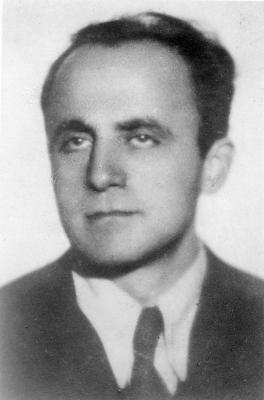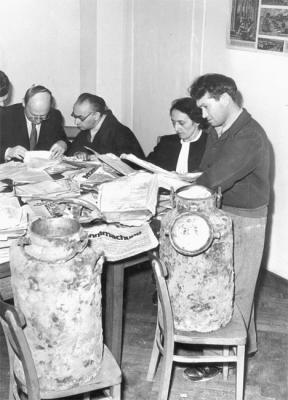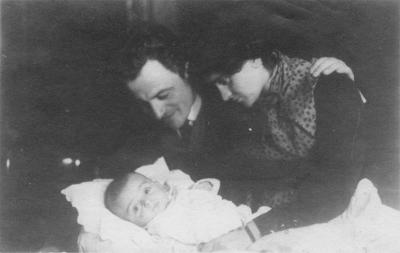The Failed Attempt to Rescue Dr. Emanuel Ringelblum
The Wolski family lived at 81 Grojecka Street, Warsaw, in a property that they owned. It consisted of a two-story building with a garden and a greenhouse that was maintained by Mieczyslaw Wolski, who was a gardener by trade. Mieczyslaw lived with his mother Malgorzata, his sisters, Halina and Wanda, and his nephew, Janusz Wysocki.
During the war, the family gave shelter to over 30 Jews, including Dr. Emanuel Ringleblum, a well-known historian and social activist, who had founded the underground Warsaw Ghetto Archive “Oneg Shabbath”, his wife Yehudit, and their son Uri.
In 1942, Halina, in agreement with her mother, brought home a Jewish woman named Wiska. Wiska quickly grew accustomed to the Wolskis and they in turn treated her like a member of the family. After about one month, Wiska moved to the ghetto, but then returned after staying there for only a few days. A week later, she went to the ghetto again, this time accompanied by Mieczyslaw. They returned two days later with a plan of how and where to make a hideout and how to smuggle Jews out of the ghetto.
Mieczyslaw immediately set about building the hideout, which was named Krysia. He received help from his sisters, Halina and Wanda, as well as from his nephew Janusz. The hideout was built under the greenhouse. It consisted of one large room, about five by seven meters. It contained bunk beds and in the center stood tables and benches. There was also a kitchen connected to the chimney of the neighboring building, owned by the Piwer firm. The entrance to the toilet was through the kitchen. There was light and water and the entrance to the hideout was camouflaged.
Mieczyslaw and Janusz brought in the first group of Jews. They were initially set up in an empty store with a big cellar and they stayed there until the hideout was completed. From that moment on, Mieczyslaw’s mother Malgorzata, as well as Halina, Wanda, and Janusz had their hands full: They were charged with making food and taking it to the hideout, and taking the trash out.
Shortly after the hideout was completed, a second group of Jews was led to it, this time around 30 people altogether. When all of them came to know the place and the conditions, a committee was set up to distribute the work to be done, such as cleaning, guarding the entrance, and so on. The members of the Wolski family also got organized. Mieczyslaw supervised everything - Janusz and Wanda were in charge of supplying items and removing waste and Halina would take care of miscellaneous things, like correspondence and shopping to buy meat and food products.
Life in the hideout carried on late into the night. Talks were carried out, language lessons were given, newspapers read. The women would cook in the kitchen or do other chores. “Every night we went with Janusz to Krysia and lived their lives, we were very eager to stay and talk. Not once did we stay there the whole night. Krysia was our whole life,” wrote Wanda in her testimony to Yad Vashem.
Dr. Ringelblum continued his work in Krysia. His well-known dissertation on Polish-Jewish relations during the occupation was written during that time. Thanks to the Wolskis, he was able to maintain contact with the Jewish National Committee that was active on the Aryan side of town.
On March 4, 1944, just before noon, Germans and blue police entered the kitchen where Malgorzata, Mieczyslaw, Wanda, and a sick Halina were sitting. They took Mieczyslaw and led him directly to the greenhouse. Wanda wrote: “Through the window I saw the Germans next to Krysia and Jews coming out of it with their hands up. I then cried to my mother and Halina: ‘Hide yourselves where you can!’... A German entered our apartment... nobody was in the apartment... The Germans loaded the Jews up on a truck, as well as my brother Mieczyslaw, my sister Maria, and my nephew Janusz and drove away. A few guards stayed. In the afternoon, they brought Mieczyslaw back to the garden... I saw my brother through the window in the staircase; he wore only a shirt and was horribly beaten up. He didn’t look like himself. He stood leaning against a wall; in a certain moment he raised his head and looked at the house, this was his last farewell... Krysia was plundered, and then burned. Blue police guards stayed behind for three more days... After the Krysia affair faded away, we returned to the house with mother. The apartment was completely ransacked, and we were treated like criminals, all our acquaintances kept their distance from us... only fear and fright did not desert us.”
All the Jews who were hiding with the Wolskis – thirty-four people in all - were murdered, including Dr. Emanuel Ringelblum and his family. Though its founder was killed, most of the archive that he had created was discovered after the war. The rescuers too paid a dear price. Mieczyslaw and Janusz were murdered, and only Malgorzata, Halina, and Wanda survived.
On June 4, 1989, Yad Vashem recognized Mieczyslaw Wolski, his mother Malgorzata Wolska, his sisters, Halina Michalecka-Wolska and Wanda Szandurska-Wolska, and his nephew, Janusz Wysocki, as Righteous Among the Nations.









